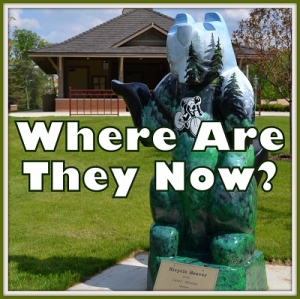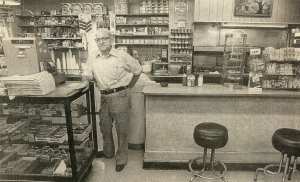Beavercreek Heritage Trail
Displaying items by tag: Beaver
In 2005, Beavercreek celebrated 25 years as an incorporated city by commissioning 25 fiberglass Beaver statues... where are they now?!
Founded in 1817 or 1818 by the Reverend Father Thomas Winters, the Beaver Congregation of the Reformed Church first met in old Father Coy’s barn and subsequently in the Coy’s School House. In 1820, the members tired of worshipping in barns and school houses, circulated subscription papers to construct a proper church. Not being able to agree on a location, they designated three options and whichever community raised the most subscription funds would win the right to choose the location. Ironically, the most central point, the northwest corner of George Long’s land, also garnered the largest subscribed amount
Over the course of many years, associated churches were formed by members of the Beaver Church congregation and ultimately kindred places of worship were constructed in Aley Church, Mt. Zion Church and also churches in Xenia and Byron.
It’s interesting to note that churches of the time were built by community, not denomination. Beaver Church was constructed by both the German Reformed Church and Lutheran congregations, holding their services on either alternate Sundays or at differing times on the same day. As communities and congregations grew, individual houses of worship were built.
We encourage you to walk Beaver Cemetery sometime; it is a veritable who’s who of the history of Beavercreek. Within the swag-chain perimeter are dozens of real-life stories of triumph, heartbreak and history. You’ll find recognize names on markers from this work, the Beavercreek Chronicles and even the roads you drive daily. Your respect is appreciated.
https://www.beavercreekliving.com/community/history/itemlist/tag/Beaver#sigProId1217d9a8f2
The Old Beaver Grade School - An Appreciation
By Bertha Trebein Flynn (c.1953)
The exact date of the erection of the Old Beaver School has grown dim with the passing of more than a half century (sic)since, long before its wrecking, it became a mute reminder of the past.
It stood not far from the Dayton Pike on a hill-slope just northwest of Beaver Church and, between 1850 and 1880 was a school of outstanding reputation in Greene County, attracting pupils from all parts of the County, including the county-seat.
It followed in imposing dignity two earlier structures, - the first, a log cabin much closer to "the pike," inadequately heated by a large fire-place at one end and provided in lieu of desks, with some crude boards, supported by heavy, sloping, wooden wall-pegs, before which pupils took turns in standing for written work. The second school building was a one-room brick structure, with a stove in the center, and with long, rough, backless benches facing rude boards fixed to the wall for holding slates, books and pencils.
Old Beaver's equipment, by comparison with its two predecessors, was comfortable and luxurious. It had individual seats at single or double desks with a space inside for books and possessions. Light fellin amply through the windows on bright days. Its original one-room was of necessity reserved after the first year or two for "the grades" and an "advanced room" was then added at the west with a front vestibule between, and an enclosed rear passage-way surmounted by a bell-tower with a bell of far-reaching resonance.
A remarkable curriculum was offered here for those aspiring to college: algebra, trigonometry, geometry, Greene's Analysis of the English Language, Latin, Greek, physics and - for the young men - the inevitable surveying. The head teacher was Mr. John W. Miller (father of the late Miss Louie Miller), who combined university training with a profound love of knowledge. So thorough was his work and that of his assistants that the students who completed the course at "Old Beaver" were able to enter the Sophomore Class at Miami University. Preparation for college grew in popularity.
For the grades there were the usual "practical" and mental arithmetic, geography, grammar, essays, spelling - now somewhat outmoded - "speeches," and the McGuffey Readers. Both Anna Snyder Perrin and Kate Snyder ("Miss Kate") gave real zest to their work, adding to it a generous use of nature's laboratory for the study of flowers and birds, - hours remembered with loving appreciation by some near-octogenarians today. (sic)
Two highly esteemed mentors of the "advanced" school's later years, who opened a new world to their pupils through their presentatin of poetry, biography, or history, were W. W. Donham and a Mr. Bonner whose initals elude memory and avalable records. One H. A. Nelson had distinguished himself and the school somewhat earlier through the staging of William Tell, for which suits of mail, sword, spears and other paraphernalia of ancient warfare were procured at what was for those times a considerable expense.
The school gave a good quota to the service in the Civil War. Five of the number achieved early captaincy: David Steele (father of the late J. D. Steele), William Glotfelter, Henry Herring, a Guthrie, and a Kirby.
"Old Beaver" closed its doors in 1882, when the march of sacrificial progress opened the local district schools of the Township.
Its years of activity remain an honored chapter in Greene County history.
As you approach the intersection of Dayton-Xenia Road on Factory Road, an early-1900’s icon sat upon the corner on your right - the Beaver Grill. Although started years earlier, the restaurant experienced real growth after its expansion from a simple pool hall in 1928. The menu was simple. Sandwiches, soup, soft drinks, coffee and candy were available. The Beaver Grill was a popular spot for BHS students to sneak to during lunch and the gracious, but business minded owners never seemed to know the Truant Officer's telephone number.
Many stories circulate about the Beaver Grill. Once Elber Shoup, a regular, became so fed up with the burnt toast that he went behind the counter, unplugged the toaster and threw it into the middle of Factory Road. Then owner Whitey Marshall got REALLY upset and was throwing a tantrum about it. Unbeknownst to him, Elber had already purchased a brand new toaster and presented it to Whitey once his face had reached a more appropriate shade of red.
Through the tragedy of fire, the death of founder Hugh Marshall and numerous subsequent owners, the Beaver Grill survived until 1982 when the location was sold.
The building was demolished in 1986 so that the intersection could be improved. A loosely organized “Club” involving plenty of coffee and tall tales frequented the Grill, their meeting place known as the Liar’s Table as they always occupied the same spot. The table reportedly made its way to different locations after the Beaver Grill closed – and rumor has it familiar faces continue to enjoy coffee and the now-even-grander stories at various places around town!
The Liar's Table has found a new home at Irongate Realtors on Kemp Road in their 'Beaver Grill' meeting space - I hear you can request it for the closing of your real estate transactions!
 Ladies of the Beaver Grill
Ladies of the Beaver Grill
Ladies of the Beaver Grill
Ladies of the Beaver Grill
 The Beaver Grill
The Beaver Grill
The Beaver Grill
The Beaver Grill
 The Beaver Grill
The Beaver Grill
The Beaver Grill
The Beaver Grill
 Beaver Grill Yearbook Ad
Beaver Grill Yearbook Ad
Beaver Grill Yearbook Ad
Beaver Grill Yearbook Ad
 The Liar's Table
The Liar's Table
The Liar's Table
The Liar's Table
 The Beaver Grill
The Beaver Grill
The Beaver Grill
The Beaver Grill
 Marshall Brother Wrecking
Marshall Brother Wrecking
Marshall Brother Wrecking
Marshall Brother Wrecking
https://www.beavercreekliving.com/community/history/itemlist/tag/Beaver#sigProIdb24fbe8595
Turn right on Grange View Drive and then right onto Timberline Drive. In 1855, this was Ealy (Aley) land including small sawmill on present day Longview Drive that was known as St. M. Located at 3937 Timberline Drive is a stately home formerly on a 179 acre estate built by John Aley in 1835. A unique feature of the home is the original double pie stairway. Most of the rooms have original windows and walnut woodwork. In 1874, it was the home of Valentine Cosler, an avid supporter of Hawker Church. Charles Beaver also bought this farm in 1948, sub-divided and developed it into Knollwood Estates.
You’re approaching Grange Hall Road. At the stop sign, glance to your right and see the approximate location of the Engle Sawmill at the intersection of Summerfield Drive.
https://www.beavercreekliving.com/community/history/itemlist/tag/Beaver#sigProId0b78e90ac1
Latest Blog Posts
- Just Don't Call Us Late For Dinner...
- Remember When...
- What A Long, Strange Trip It's Been...
- Snow Down = Slow Down
- School Bus Safety - Just Do It!
- Stevenson Road Covered Bridge
- Our Road Crews Are Worth Their Salt!
- The Most Colorful Of Seasons!
- Popcorn Fest! - Then And Now
- Pre-School Paradise!
- Remembering Riffles
- Ten Year Anniversary Of The Beaver Statues









